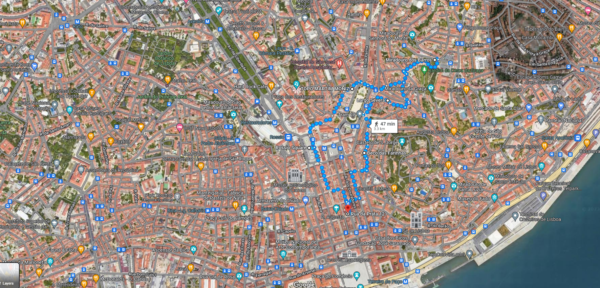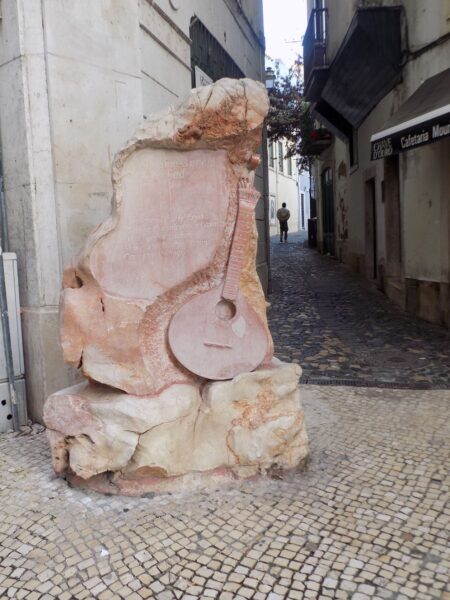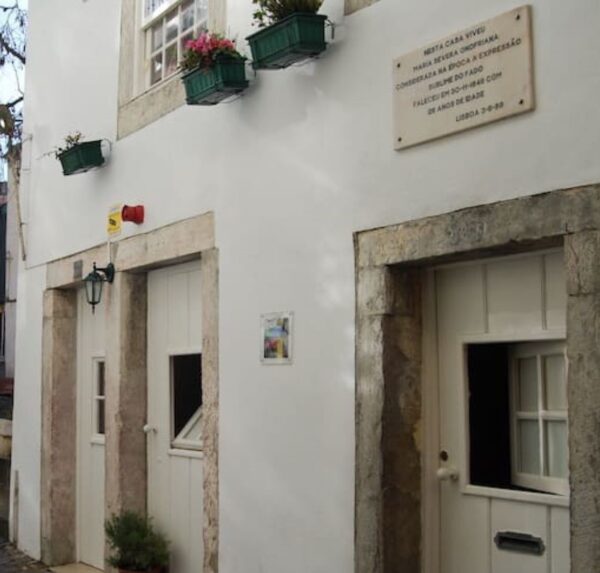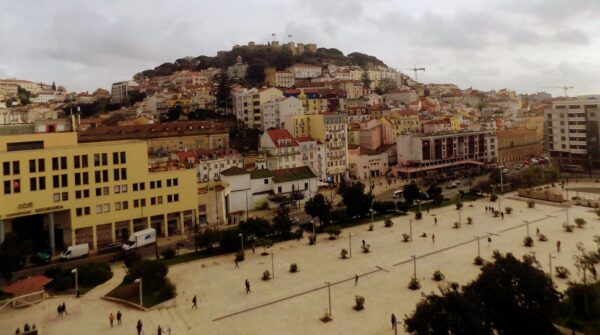Before I took you through the story of how bica came to Lisboa, I’d just finished a little snack of pasteis de nata accompanied by that most Portuguese beverage. As I was noshing, I began searching my pockets for my things to see and do list and discovered that I’d either left it in the flat or dropped it along the way. This elicited a slight growl and three D’oh-p slaps that led to a stop at another stall on the street side of the market where I fortified myself with some ginjinha in a chocolate cup. (Generally in Lisboa, you drink ginjinha ‘com ou sem’ – with or without the cherries – from a shot glass but this situation called for a little something extra.)
From red light to Pink Street.
Even if you go to the Time Out Market with a guide she might or might not tell you all about the neighborhood called Cais do Sodré where it resides. Although the name Sodré has been long associated with the area (from a family of English origin who owned several properties in the area), it was more commonly called Remolares (likely for the paddle grinding businesses near the river) until after the 1755 earthquake. As the Marquis de Pombal oversaw the city’s reconstruction, the toponym Cais do Sodré became the norm. By the early 19th century, the area was a maritime hub and foreign sailors looking for some fun on shore began patronizing the area’s establishments. And, as one might expect, many of these sailors were looking for more than mere food and drink. Willing (or perhaps some unwilling) locals accommodated them and they found what they sought for well nigh 200 years. A story about the area from the BBC describes it this way,
For years, riverside Cais do Sodré was one of Lisbon’s seediest neighbourhoods. Its backstreets were the haunt of whisky-slugging sailors craving a little after-dark sleaze; a lacklustre place where brothels sidled up to sweaty clubs.
That changed in 2011 when the government decided it was time for a makeover. The heart of the area where sailors sought their “after-dark sleaze” was the Rua Nova do Carvalho home to gambling dens, brothels, and dive bars named after other port cities. It was also a meeting point for local criminals. Beginning in 2011, the call girls and gambling dens got their eviction notices while the bars were made to clean up their acts and transform into more respectable eateries and music clubs. As part of the gentrification effort, the government gave the street a new look:

and it’s now called (at least colloquially) Rua Cor de Rosa or Pink Street. Since I was in the neighborhood and it seemed like a good opportunity to get an uncrowded photo, I made a brief pass before returning to the apartment to reformulate the day’s plan. (I’ll return to Rua Cor de Rosa tomorrow for a meal that you can eat more or less anywhere in a style that likely started in southern Europe but still probably strikes most Americans as an odd restaurant choice.)
Walk the Walk.
Those of you who have come away with me as I recount my various adventures know through my statements or through your observations that, while I rarely amble, I have an embedded belief that perambulating a city is among the best ways to come to know it. This is how I intended to spend substantial blocks of my time in Lisboa. It wasn’t my intent, however, to retrace a nearly identical path back to my rental so soon after setting out from there but such was my fate on this first morning. Fortunately, it was only about a kilometer from r Cor de Rosa to the apartment and the terrain is, like the neighborhood of Baixa, mostly flat. Knowing Lisbon’s general topography, I was fairly certain my walks would get hillier as the day (and weeks) progressed.
Following a fruitless search of my flat for my notes, I decided on this new plan for the day:
- Get a little lost wandering about the old Moorish quarter called Mouraria.
- Stop at the trendy bar Topo above Praςa Martim Moniz for its views of the castle and grab a snack that might make a later dinner than usual more comfortable.
- Walk up the hill to the Miradouro dos Barros before returning to the apartment for a brief rest before dinner.
- Get a little lost again wandering about the old Moorish quarter called Mouraria on the way home.
I didn’t set out directly for Topo and, in fact, really didn’t get into Mouraria until I left the bar and made my ascent to and subsequent descent from the miradouro. (I’ll have more to say about miradouros later.) As nearly as I can reconstruct it, the walk probably looked something like this (from Google Maps):.

If you enlarge the map, you’ll see that the total distance of this circuit is a less than intimidating 3,300 meters. Keep in mind, though, that I’d already put in something over two km walking to and from Time Out Market and Pink Street. One element the map doesn’t show you is that the ascent to the miradouro exceeded 120 meters (about 370 feet) with more than half of that coming between Topo and the Miradouro dos Barros.
Mouraria is the neighborhood just to the west and perhaps a little south of the trendier Alfama. They share certain hills and certainly for an outsider it’s all but impossible to tell where one neighborhood begins and the other ends. Mouraria is considered by many to be the birthplace of fado and this monument makes that claim explicit.

It is certainly the birthplace of the famous fadista Maria Severa.

The neighborhood remains among the least gentrified neighborhoods in Lisboa and some say it’s the one that most reflects the city as it was in the days prior to the 1974 Carnation Revolution.
After covering some familiar ground walking toward Rossio and Restauradores, I set my sights on getting to Topo. This presented the first opportunity to try out a newly downloaded app from Organic Maps. This is a free, crowd-sourced app that uses Open Street Data, works offline and doesn’t track you in any way. The more I used it on this trip, the more I liked it.
I’d read about this bar on Spotted by Locals and, since it was relatively close by, thought I’d give it a whirl. The view

was nice though perhaps not quite as thrilling to me as the SBL guide found it. The food (a couvert and six small vegetarian samosas washed down with a cerveja) was also interesting and, while not expensive, was a bit toward the high end of a restaurant in Lisboa. But, as Ana would tell me later in the trip, at certain places in Lisboa, you’re paying for the view, the ambiance, or the notoriety and not the food.
More interesting for me was watching the interaction between the bartender and the three young, very attractive women sitting at a table opposite mine. I wasn’t close enough to eavesdrop (and wouldn’t have understood regardless since they were speaking Portuguese) but I thought his intentions seemed apparent. I paid my bill and left before I could note his ultimate success or failure. I had a miradouro to find.
per·am·bu·late
walk or travel through or around a place or area, especially for pleasure and in a leisurely way.
Had to look this one up. Great addition to my vocabulary bag.
Really enjoyed this one. As a fan of the idea of Red Light districts in general, and having visited several over the years, just to experience the ambience of course, I appreciate that you went back to 1755 to start the segment until ending with the very cool, Pink Street, accompanied by a great picture.
I thought I read that you were going to put the number of songs in parenthesis after the title for each post. If I am mistaken, you may want to consider putting the number somewhere in the post for those of us competing in the contest.
P.S. I think I found one and have ideas for a couple of others…
yes. I often walk around places for pleasure but rarely in a leisurely way.
The number of songs per post is in the email that I send out to the group and also in the comment I posted on Testudo Times but I think yours is a good idea and I will retroactively address the first three and use it going forward.
By the way, thank you turning us on to Organic Maps. I just downloaded it and allowed my location and it has zeroed onto my house. Literally, our house is in the circle. The map is also exquisitely detailed. I walk every day and my wife joins me at least 4 days a week. I can already see streets we have missed, and when we decide to branch out to other areas, this will come in mighty handy.
Works off line with no tracking, too. Sometimes it can miss specific addresses if they’re not in the open source data. However, (if you’re a little more computer savvy than I am, you can fix that by setting up an account at open source http://www.openstreetmap.org and adding the data yourself.